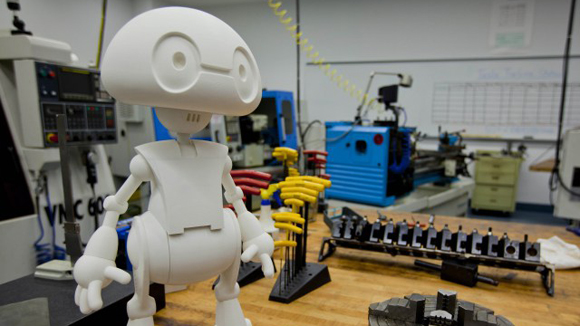The Third Industrial Revolution: how long until we manufacture everything ourselves?
Aruba Networks Workplace Futures report: Part 3

As our work spaces are changing, so too are what we produce in them, says The Future Laboratory co-founder Chris Sanderson, referring to the swift and stealthy onset of the so-called Third Industrial Revolution, a time when 3D printing becomes mainstream.
With the cost price of 3D printers falling, and the software used to program them becoming simpler to use, high-performance fabricators will enter the home in a more meaningful way, he believes.
The size and growth rate of the 3D printing industry illustrates how suddenly the 'Third Industrial Revolution' will be upon us. In 2013, 3D printer sales, materials and associated services reached $2.5bn (€1.8bn, £1.5bn) worldwide, according to research firm Canalys. This figure is expected to rise to $3.8bn (€2.8bn, £2.2bn) in 2014, before reaching $16.2bn (€11.9bn, £9.6bn) by 2018.
"This is a market with enormous growth potential now that the main barriers to uptake are being addressed,' says Canalys senior analyst Tim Shepherd. 'Crucially, prices are falling, making the technology an increasingly feasible option for a broad variety of enterprise and consumer uses."
3D printing prices falling
Mirroring the era before the industrial revolution, when artisans would sell their products in the shops over which they lived, manufacturing will come home, as people print rather than buy products.
"This will happen slowly, as there are tricky accessibility hurdles concerning the software in 3D printing," says Nicholas O'Donnell-Hoare, chief designer at 3D printing practice Saint-H.
"But in around 10 years' time, the 3D printing revolution will begin suddenly as people print household components to slow our throwaway culture, before moving on to more complex and significant products such as printable electronics."
Are you a pro? Subscribe to our newsletter
Sign up to the TechRadar Pro newsletter to get all the top news, opinion, features and guidance your business needs to succeed!
Sanderson argues that these changes will be even more profound. "Essentially, we are witnessing the collapse of traditional hierarchies in industrial spaces and organisations," he says.
"By allowing us to 'micro-fabricate' products locally, and on a very bespoke level, 3D printers will lead to the collapse of traditional manufacturing. It will also see the role of the worker merge with that of the designer, prototyper, manufacturer, even the distributor and retailer."
Collapse of the manufacturer?
Projects such as Mash Up by Dutch designer Diederik Schneemann show the new power shifts that will occur on the back of the 'Third Industrial Revolution'. Schneemann took a series of iconic designs including the Rietveld chair, and remixed them, adding new tweaks to the design to open a debate around ownership of form in a world on the brink of a 3D fabrication revolution.
"We are facing a crisis point in design equivalent to the one the music industry had when streaming sites such as Napster started giving tracks away free," says Schneemann. "When anyone can download a design, print it and make it their own – who can own a shape or a form?"
As the 'Third Industrial Revolution' kicks on, jobs will become blurred, careers more about being creative, collaborative and cloud-based – the three Cs of future work practices – while "factories will be transformed into facteliers, high-concept, artisanal style showrooms, where you choose a product, touch a screen, make adjustments and print it."
In this vision of the future, Sanderson says that the same printers, thermoplastics and digital raw materials will be used and adapted to print anything from a table to sections of the human face – "and that is the real shift we are not prepared for."
"Simply put," says Sanderson, "we are witnessing the death of the sector-based work space and industries. The rapid prototype designer, drawing on the right data from the cloud, will be able to customise, design and print anything, from the same machine and in the same space."